How to Choose a Hearing Aid: Tips From an Audiologist
This guide will teach you about the different types of hearing aids and how to choose the right one for your needs.
This guide will teach you about the different types of hearing aids and how to choose the right one for your needs.
SeniorLiving.org is supported by commissions from providers listed on our site. Read our Editorial Guidelines

If you're new to the world of hearing aids, you may be full of questions and feel overwhelmed with the myriad choices. As with any new endeavor, learning more about the topic will help put your mind at ease and give you the confidence to make the right choice.
I began practicing audiology in 1992. Over the years, I've seen thousands of patients and have actively involved myself in consumer groups for hearing loss. I wrote this guide to equip those experiencing hearing loss with the knowledge they need to find a hearing aid.
In this guide, I'll explain the different types of hearing aids that are available so you can decide which will work for you or your loved one. I'll also explain the types of hearing loss that can occur — and the early warning signs you should know.
Are you looking for affordable hearing aids that fit your budget? Or do you want top-of-the-line hearing aids providing the best sound quality and features? Maybe something in between? Regardless of your needs, we can help with up-to-date information, hands-on reviews, and general guidance. Check out some of our favorite hearing aid brands below for more information.
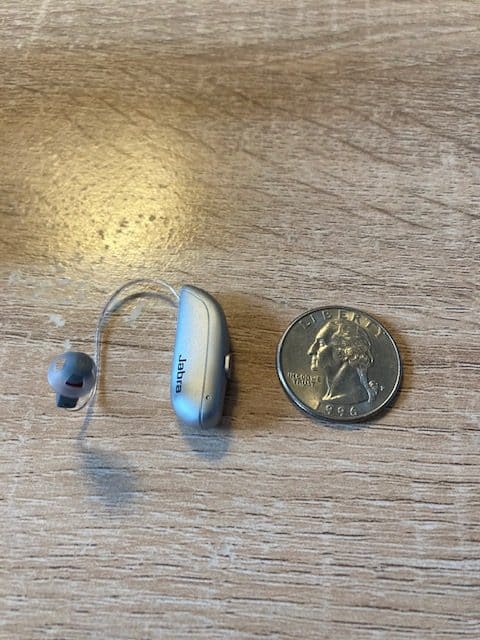
We’ve researched and reviewed the industry’s top providers to help you find the best hearing aid for your needs.
Our detailed, hands-on reviews of the industry’s most popular hearing aids will give you an inside look at our experience with the company’s products and our key takeaways.
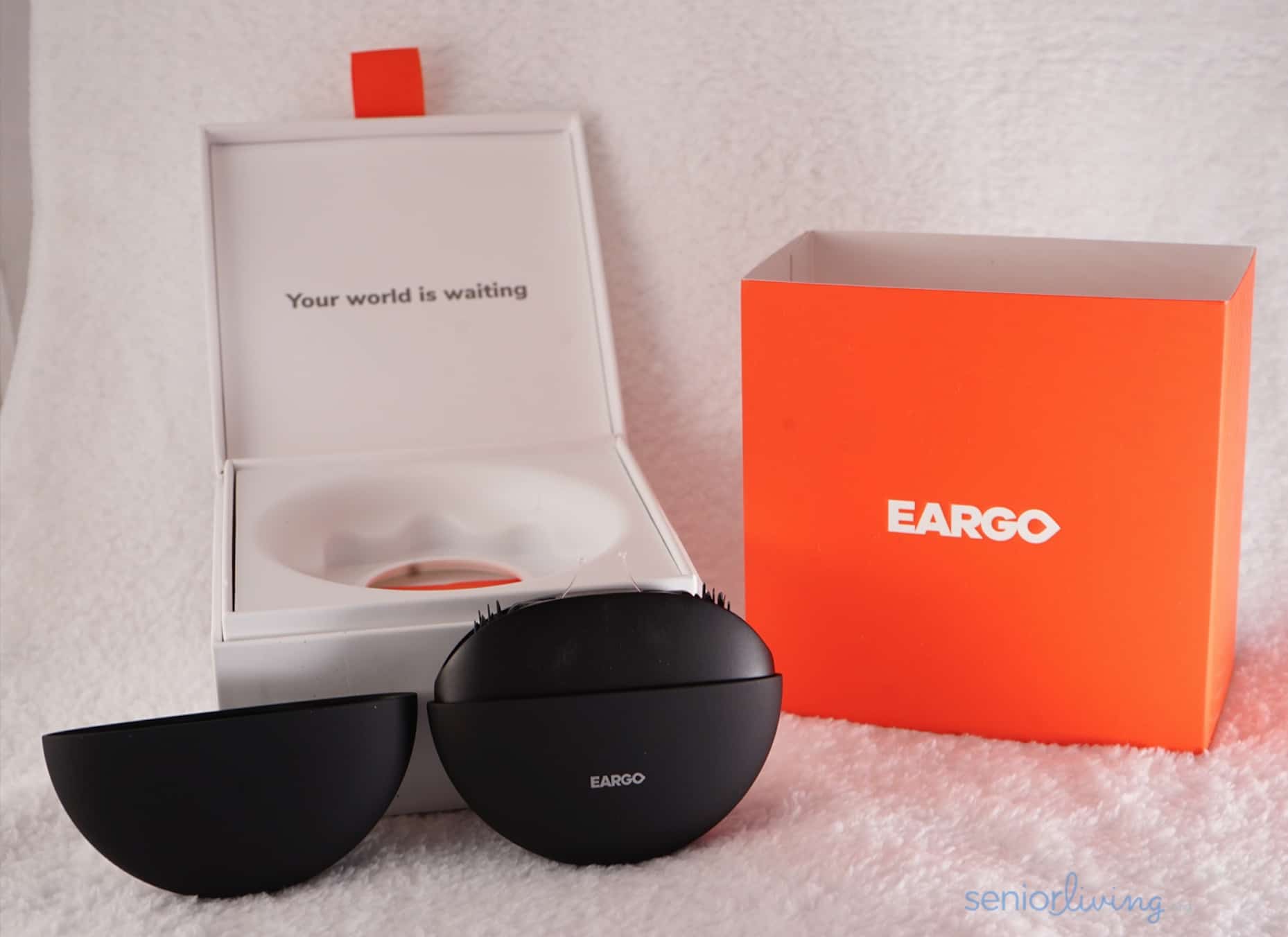
Want a closer look at pricing and value? Visit our pricing pages for these popular providers to learn more and learn how to get the best deal on your hearing aids.
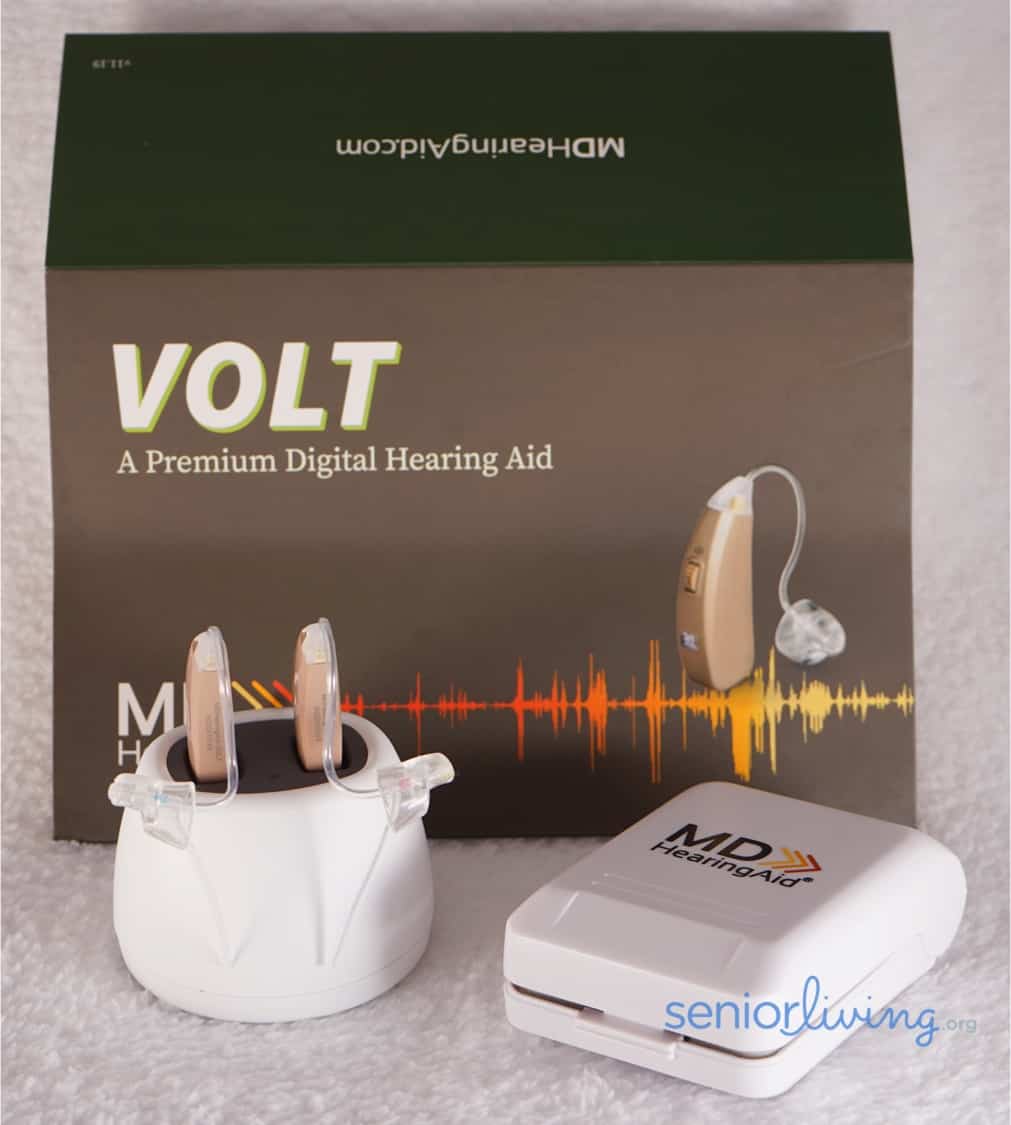
With so many hearing aids on the market, comparing providers side by side is a helpful way to determine which device is best for you. If you’re struggling to pick between two providers, take a look at our comparison pages.
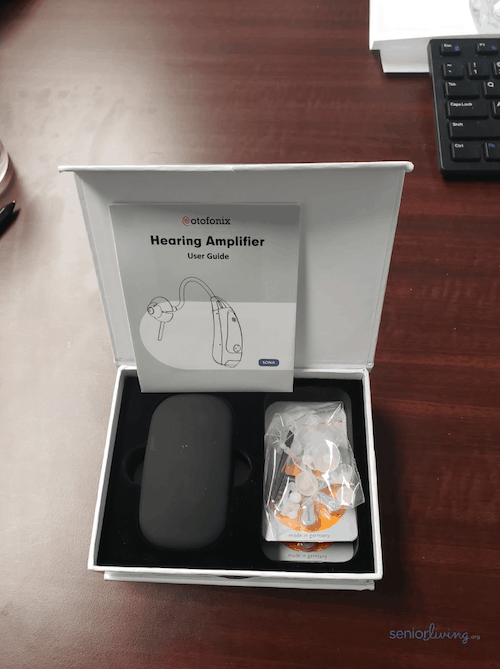
Whether you’re looking for step-by-step how-to guides or resources on Medicare coverage for hearing aids, we’ve got you covered with a wide range of additional hearing aid resources.
I began practicing audiology in 1992. Over the years, I’ve seen thousands of patients and been actively involved in consumer groups for hearing loss. I wrote this guide to accomplish a few things.
First, I’d like more people to seek help for hearing loss. Millions of Americans (mostly seniors) have hearing loss. A discouraging fact has rung true for almost a century: just 20 percent of people who would benefit from a hearing aid wear one.1 In my experience, a big reason for that is a lack of knowledge. This guide aims to address this.In my experience, a big reason for this is a lack of knowledge. This guide aims to address this.
Second, I wanted to open the curtain on the seemingly endless options for hearing aids. Just like buying a car, there are hundreds of makes and models to choose from. But if you zoom out a bit, all of them have four wheels, a frame, a motor, and a body. Beyond that, most models just differ based on convenience and style. Hearing aids are much the same.
Finally, I wanted to arm you with some not-so-common tools to weed out the good, the bad, and the ugly in terms of who actually dispenses these devices. Returning to the car analogy, you want a mechanic who won’t quit “wrenching” until your ride is purring like a kitten. With a smidge of knowledge and healthy skepticism, you can push your “hearing mechanic” to help you hear the best you can.
Hearing aids are electronic devices worn in or behind the ear. Hearing aids improve the lives of those with mild to significant hearing loss. But, as I counsel my patients, they aren't a cure for hearing loss. Rather, they improve the quality and level of sound around you. It increases your ability to comprehend human speech and enjoy the sounds of life while they're being worn. Once you pop them out, your hearing will revert to its natural state.
The moral of the story? You have to wear hearing aids to reap their benefits. That's why buying the right type is so critical. Hearing aids that don't work tend not to be worn.
Hearing aid technology is constantly changing and improving. But in general, most hearing aids work similarly. When you wear a hearing aid, sound vibrations enter the ear and travel into the ear canal. These vibrations continue to travel through the eardrum and the small bones of the middle ear and into the inner ear. That's where the sound is processed and sent to the brain.
Hearing aids contain one or more microphones that pick up sound, a digital amplifier that makes sounds louder, and a receiver that sends sound into the ear canal. These components work together to amplify and crystalize the sounds around you. Many hearing aids are even engineered to prioritize important sounds, like voices.2
Answer a few easy questions to find the hearing aid that’s right for you.
Now that you have some general knowledge about the hearing aid types from the previous section. Take a moment to check out this video on the Types of Hearing Aids from the Senior Living YouTube Channel. In this video, we cover all of the major hearing aid types, how they work, and some of their functionalities. Hear all of this information directly from our resident audiologist Brad Ingrao, Au.D.
Hearing aids fall into two major categories — in-the-ear (ITE) and behind-the-ear (BTE) — and a few subcategories regarding style or shape. In general, the internal electronics are the same across styles of a given model, but some features may not be available in certain styles due to size. The currently available styles are as follows:
As you can see, there are a lot of options when it comes to the size and shape of hearing aids. As an audiologist, I've noticed that most patients prefer not to advertise their hearing loss. The exception is typically younger folks who opt for bright and noticeable BTE versions. People who prefer very discreet hearing aids should see if the invisible-in-the-canal (IIC) or extended wear (EW) options are appropriate for their hearing loss level and needs.
Unless you're completely bald, the receiver-in-canal (RIC) style is nearly invisible in most cases. That's because they can be color-matched to your hair. Hearing aids that look good (or at least acceptable) are very desirable; however, it’s essential to realize that going that small means you may have to compromise on some features.
Take a moment to check out our video on types of hearing aids below. This video covers all major hearing aid types, how they work, and some of their functionalities.
Now that we know what types of hearing aids there are, let's talk about hearing anatomy; it will help you better understand what causes hearing loss and how to address it. The human hearing system has four parts:
The type of hearing loss you have determines the kind of hearing aid your audiologist will recommend to you.
Hearing loss can refer to the inability to hear volume accurately, AKA “hearing sensitivity.” Hearing loss can also refer to the inability to hear sounds accurately within specific frequencies; it's called “hearing discrimination.”3
We separate hearing ability into which parts of the hearing mechanism are affected (type of loss), plus how loud sounds need to be for you to hear (severity of loss).
Now that we know a little about what might cause hearing to degrade, let’s talk about how to find out if your hearing isn’t up to snuff.
People with hearing loss tend to exhibit or notice one or more of these behaviors:
In the video below, I further discuss how to spot the early signs of hearing loss with SeniorLiving.org's Editor-in-Chief, Jeff Hoyt.
If you do any of these things more often than you change the oil in your car, you should have your hearing evaluated. There are two basic forms of checking out your hearing: a screening and an evaluation.
A hearing screening is used to determine if hearing loss likely exists. It's not a diagnostic test, and it won't identify the specific type of hearing loss you may have or its likely cause.
These types of tests generally only address the sensitivity part of hearing. They're quick and typically free. Like other types of health screenings, a hearing screening lets you know if further investigation is needed. Hearing tests are available in many apps and websites where hearing aids are sold. You can also use SeniorLiving.org's online screening test as a first step.
Quick Tip: Are you looking to take a hearing test for the first time but unsure where to start? Visit our guide on how to take a free online hearing test.
A hearing care professional may also recommend a type of test called a pure-tone audiometric screening. These are identical to your hearing test in the nurse’s office in elementary school. Like smartphone apps, they offer insight into your hearing abilities and indicate if further testing is warranted.
They may also recommend a speech discrimination test. This type of test analyzes your ability to clearly hear and discern speech. Presbycusis — age-related hearing loss — often begins with reduced higher-frequency hearing ability. This test helps sleuth that out.
If your hearing screening suggests that you may have hearing loss, it’s best to have a complete hearing evaluation. That can be performed by either an audiologist or a licensed hearing instrument specialist.
Your hearing evaluation will include several tests, including:
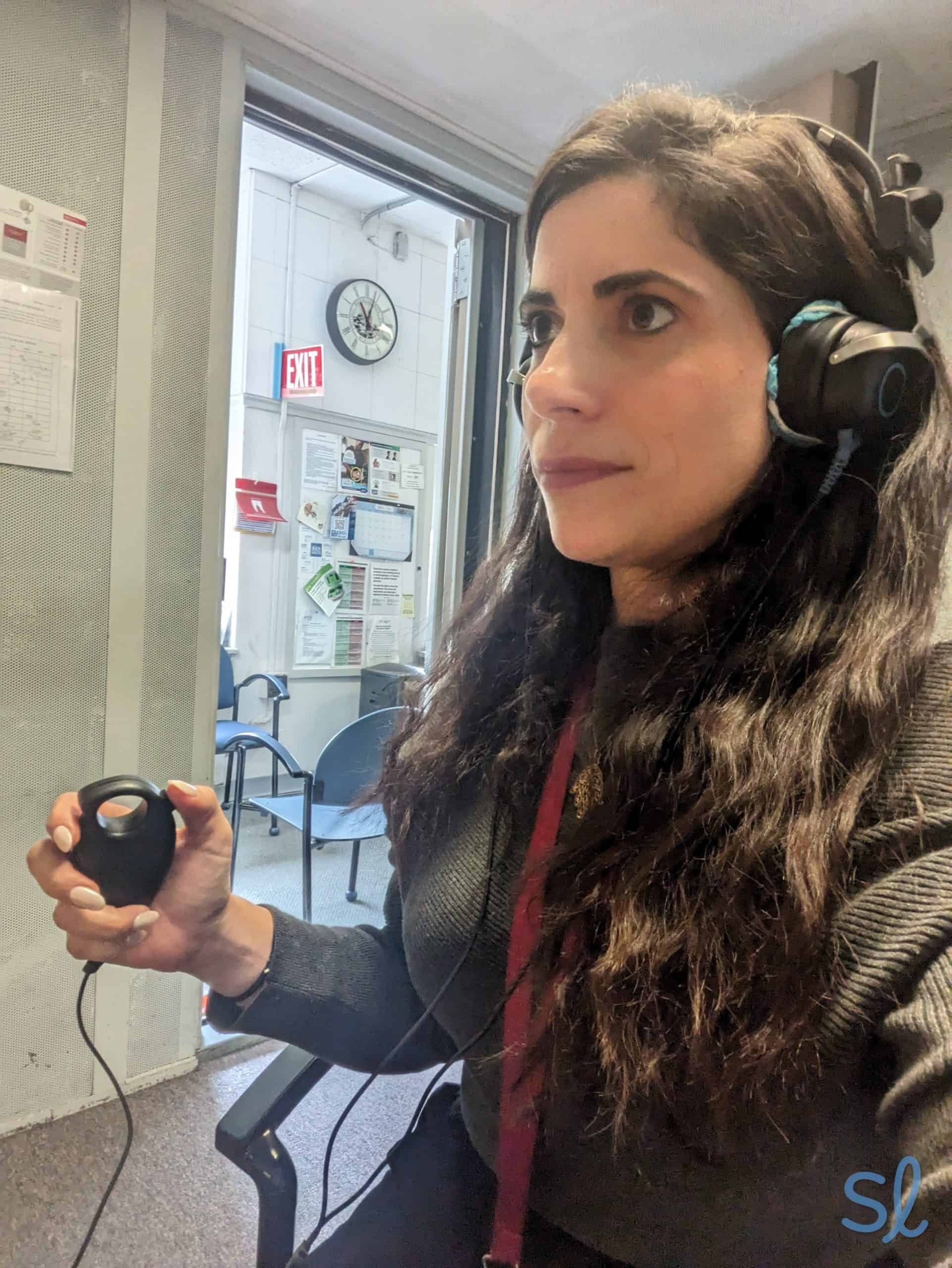
Audiologist Dr. Ruth Reisman demonstrates taking a hearing evaluation
Making an appointment to visit the doctor can be stressful, but your first audiologist visit doesn't have to be! Audiologists are trained professionals who specialize in hearing and the ear. They can provide you with a thorough assessment of your hearing loss. Things will be crystal clear in terms of your hearing and your knowledge of your ears by the end. Watch the video below to learn what to expect during your first audiologist visit.
That depends on the level of hearing loss you have. In October 2022, new legislation was passed that allows hearing aids to be sold over the counter. These over-the-counter (OTC) hearing aids are designed for adults with mild to moderate hearing loss and can be purchased online or from a drug store. Check out our guide to OTC hearing aids to learn more.
There are not currently any OTC solutions available for severe to profound hearing loss; those with higher levels of hearing loss need a prescription for hearing aids suitable to their needs. Prescription hearing aids require an in-person visit to a hearing care professional to assess your hearing needs and help you find the best solution for your hearing loss.
There are several places to buy hearing aids, including audiology clinics, retail chains, VA medical centers, and online. Below is a complete list of where you can purchase hearing aids:
Hearing aids are miniature computers that process sound digitally and in real-time. They offer many confusing-sounding features with no standard language. Instead, each manufacturer has its own catchy name. Below are the most common hearing aid features described in as generic terms as possible.
In almost 30 years of fitting hearing aids, I rarely encounter patients who hear their best in the real world of noise with just their hearing aids. Fortunately, there are tools to help.
Nearly all ITE, RIC, BTE, and some CIC hearing aids can connect wirelessly to external devices — collectively called accessories. The idea is to overcome the challenges of distance, reverberation, and background noise by capturing the desired signal (speech, music, TV, etc.) in an ideal condition; then, it's beamed to the hearing aids across distances ranging from 30 to 80 feet, depending on the wireless technology. Wireless hearing aid accessories fall into a few categories:
These tiny devices clip onto the clothing of the person who is speaking or the person wearing hearing aids. There are also remote microphones available you put on a table, such as in a restaurant or conference room, so you can hear everyone speaking more clearly.
Hearing the television well depends on several things: the size and shape of the room, whether you’ve updated the shag carpet you installed in the ‘70s, the quality of the speakers, and the recording quality of the program.
A media streamer neutralizes all these variables by taking a direct, hard-wired audio signal from the TV or cable box (RCA or digital TOSLINK) and beaming that signal to the hearing aids, akin to the remote microphone. Most are easy to set up; once they are set up, they either automatically connect, or you just tap a button on the hearing aid or use a smartphone app to activate streaming.
Even the largest hearing aids have small buttons. Those with wireless capability offer options to control volume, programs for different listening situations, and streaming using a smartphone app or a dedicated remote control. The stand-alone remote controls are usually the size of a key fob, and they either use a long-life watch-type battery or are rechargeable.
Almost all wireless hearing aids offer a smartphone app. These apps are generally available on both Apple (iOS) and Android; they're provided free from the manufacturer.
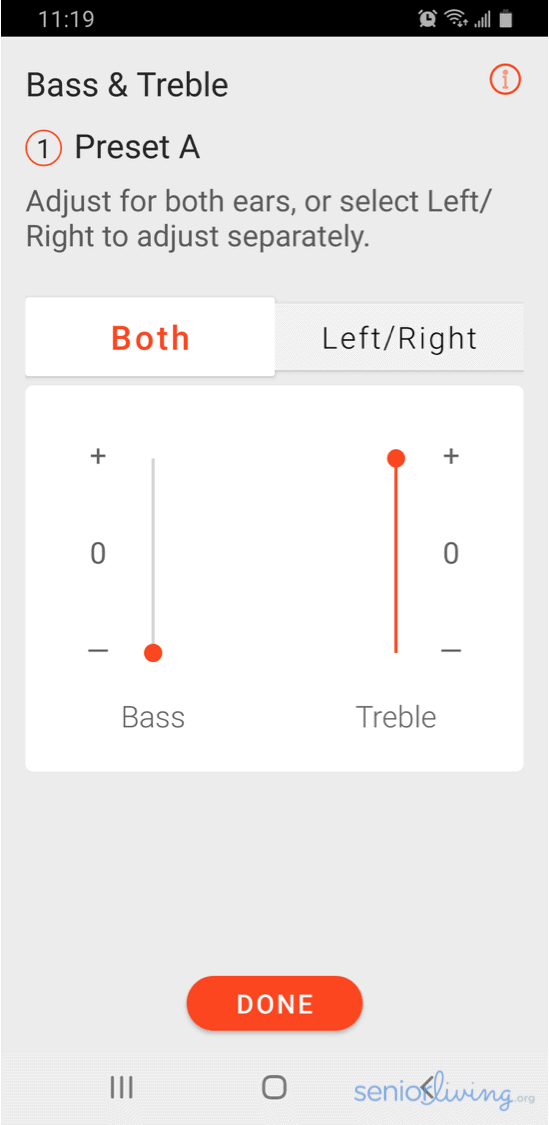
Eargo App Bass and Treble
In addition to basic hearing aid controls like volume and program selection, some apps offer added services like geotagging. This functionality serves two purposes: First, it allows you to fine-tune the hearing aids and accessories in specific settings, like your favorite bistro; then, it has them automatically go to those settings every time you walk in the door. Secondly, geotagging allows the app to “find” a misplaced hearing aid. Hearing aid apps may also provide audiological support, remote programming capabilities, and tinnitus-masking sound libraries.
Check out my interview with SeniorLiving.org Editor-in-Chief Jeff Hoyt for more information on hearing aid accessories.
This technology is quite old — appearing first in hearing aids in the 1930s. Tcoils are electromagnetic receivers that pick up sound transmitted from hearing-aid-compatible telephones and special public address systems called “hearing loops.”
Hearing loops are becoming more popular around the U.S. in places like airports and convention centers. Using them provides the same benefit as a remote microphone — without having to clip anything onto clothing.
Tcoils are recommended in all hearing aids by the Hearing Loss Association of America.8 They are so effective that several states require a signature indicating that a discussion of them occurred during your hearing aid consultation.
Hearing aids, like all electronics, need power to operate. This function was traditionally accomplished with a small, disposable battery. Current versions of these use a “zinc-air” technology; this provides between three and 22 days of use, depending on the size and power requirements of the hearing aid.
In the last few years, rechargeable options have become widely available. Most rechargeable hearing aids fully charge in an hour or two and provide 24 hours of use time.
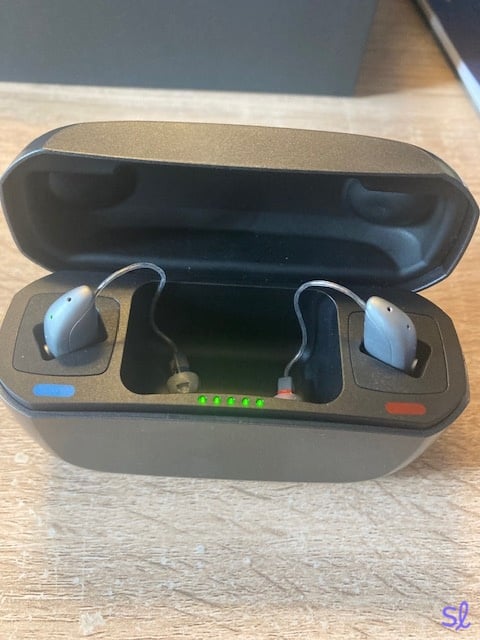
Charging Jabra Enhance Select 300 hearing aids
Everyone, even those with perfect hearing, has more difficulty understanding speech in background noise. Directional microphones lessen that difficulty. The degree to which directional microphones allow you to hear successfully in noise depends on your difficulty hearing and the noise level in the environment. The difference between the loudness of speech and noise is called signal-to-noise ratio (SNR) and is measured in decibels (dB).
If a hearing aid can use wireless accessories, it can probably also stream directly from devices like your iPhone, iPad, or Android phone. For instance, if your phone rings, you can answer it and hear the conversation directly through your hearing aids.
Direct streaming uses Bluetooth LE or newer Bluetooth Auracast broadcast audio technology. Streaming enhances your ability to hear telephone conversations clearly and to better hear media such as YouTube, Netflix, and podcasts.
Auracast also lets you share your audio with others. This improved technology is poised to become the next generation of assistive listening technologies.
Modern hearing aids, particularly Lithium-Ion rechargeable models, have all been designed to resist moisture and dust. These water-resistant hearing aids are not technically waterproof but can hold their own in the gym, rain, or humid climates. Some hearing aids, like Phonak's Audéo Life, are waterproof. These can be worn while showering or even swimming.
Hearing aids often have programming capabilities that mimic how your ears naturally adapt to changes in the sound environment. These vary by brand and style. You may be able to change your program through an app or the hearing aids themselves. Some of these hearing environments are:
Your hearing aids may also come with programs that log hours of use, social time, and battery life. Some provide health-tracking data, like the number of daily steps and automatic fall detection.
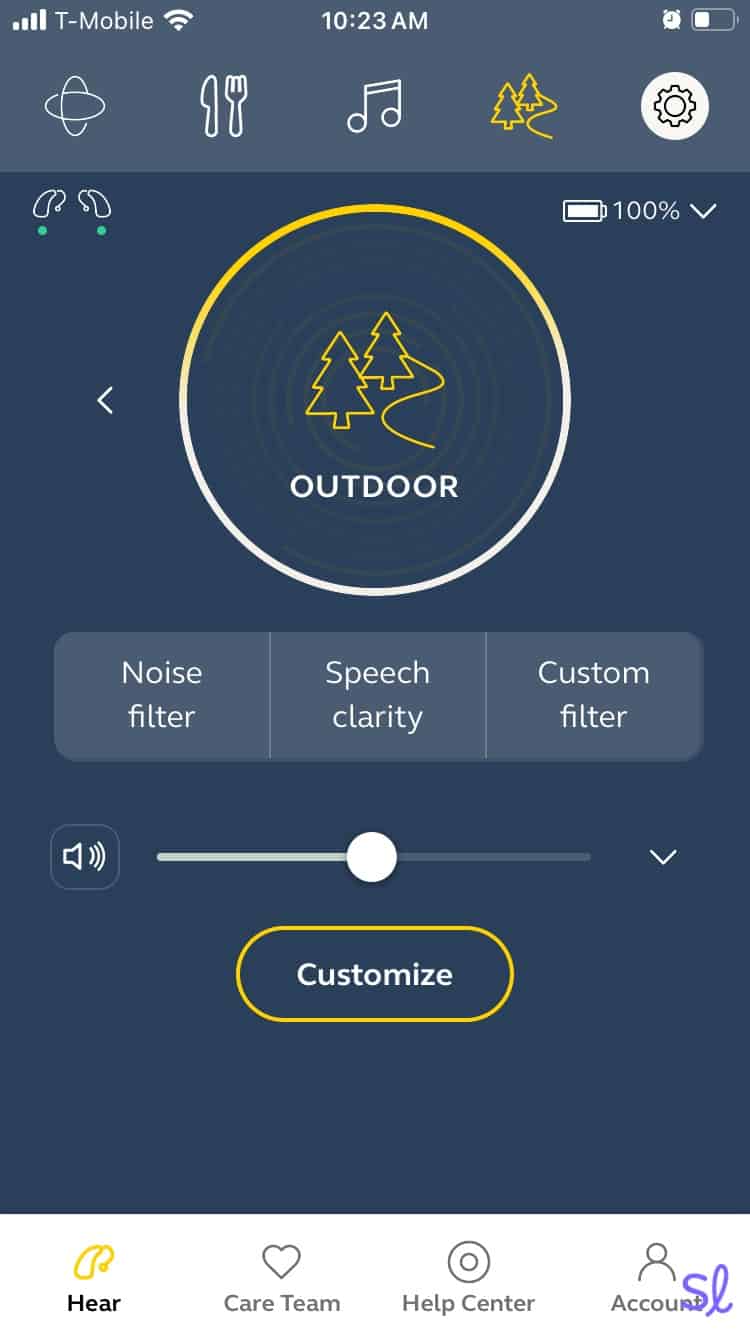
Making adjustments using the Jabra Enhance mobile app
Whether you buy them OTC or get them by prescription, hearing aids can be a heavy financial burden. Keep these things in mind before you buy:
Pro Tip: If you’re worried about the price of hearing aids, there are a few ways to reduce the cost. Head to our guide on how to get free hearing aids for more details.
If you purchase OTC hearing aids, the devices will be shipped right to your door — you won't need to visit a hearing care professional for fittings or adjustments. OTC providers typically offer remote help. You can get all set up from the comfort of your home; however, these hearing aids aren't usually as customizable as prescription hearing aids. Some OTC hearing aids may even be preprogrammed with little to no room for adjustments.
Keep in mind that wearing hearing aids has a learning curve. Allow yourself time to adjust. In the long run, this will provide you with enhanced hearing ability and, hopefully, more enjoyment of life!
After purchasing prescription hearing aids, you need your devices fitted and programmed to your specific hearing needs in person. If you work with an audiologist, the hearing aids you select will be ordered; then, you will return for a fitting between two days and a few weeks. The audiologist will adjust your hearing aids to fit your ears and set your sound levels for optimum listening throughout multiple environments. They'll explain how to use all the programming features, such as using Bluetooth, while you drive. Of course, they'll also answer any questions you may have.
If properly fitted, hearing aids shouldn’t need many adjustments. However, it’s vital to specify precisely how many adjustment appointments come in the price and how much additional service might cost. It varies between providers, and it can represent significant ongoing costs.
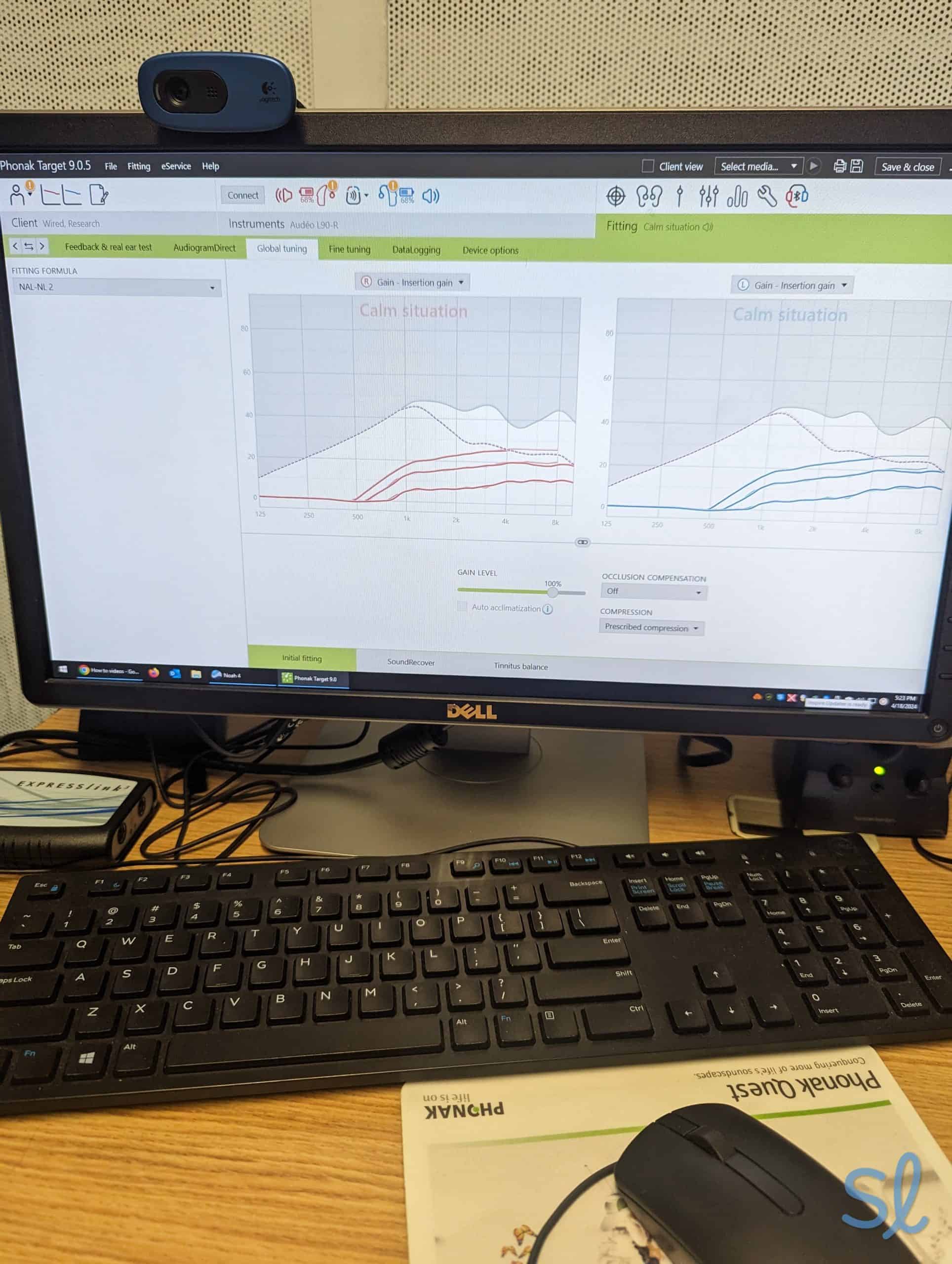
Dr. Ruth Reisman testing and customizing a pair of hearing aids
As you can see, getting hearing aids is not as simple as grabbing a pair of readers off the rack at the drugstore. Nor is it an impossible task!
Hearing is one of our primary senses because it connects us with the thoughts and emotions of those in our lives. As such, it's worth researching thoroughly, asking hard questions, and being patient to find a solution and provider that matches your needs and personality.
After the devices hit your ears, a process of neural rewiring begins that can take up to three months, so be patient. Seek the advice of others who have walked in these new and louder shoes. On the lighter side, remember that the volume control on your new hearing aids gives you the superpower of reducing the rhetoric and amplifying the awesome!
Stanford Medicine. (2018). Hear and now.
RadioEar. (2020). About Us.
Hearing Health Matters. (2015). Hearing Quotes and Sayings.
NIDCD. (2016). Quick Statistics About Hearing.
Center For Hearing Loss Help. (2020). Ototoxic Drugs Exposed.
ASHA. (2006). Autoimmune Inner Ear Disease.
Etymotic. (2020). QuickSIN™ Speech-in-Noise Test.
HLAA. (2020). HLAA.
HLAA. (2019). House Passes Bill for Medicare Coverage of Hearing Aids.
Starkey Hearing Foundation. (2020). Starkey Hearing Foundation.
Healthy Hearing. (2019). Hearing loss statistics at a glance.
WHO. (2020). Deafness and hearing loss.
AARP. (2018). Untreated Hearing Loss May Raise Risk of Other Health Issues.
WHO. (2020). Deafness and hearing loss.
The Hearing Review. (2020). Hearing Aid Unit Sales Increase by 6.5% in 2019.
AARP. (2019). How to Convince a Loved One to Wear a Hearing Aid.
NIDCD. (2020). Hearing Aids.
AARP. (2019). 8 Ways to Save Money on Hearing Aids.
AARP. (2019). Latest Hearing Aids Have High-Tech Advances.
Statista. (2020). Global hearing aids market share in 2018, by distribution channel.
Markets and Markets. (2017). Hearing Aids Market by Product (Receiver In The Ear, Behind The Ear, In The Ear, In The Canal Hearing Aids, Cochlear Implant, BAHA implant), Types of Hearing Loss (Sensorineural, Conductive Hearing loss) & Patient (Adult, Pediatric) – Forecast to 2022.